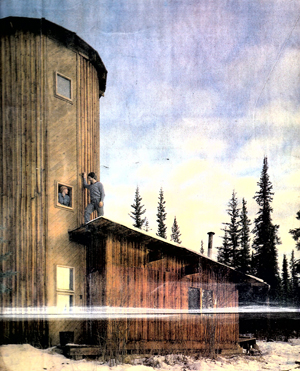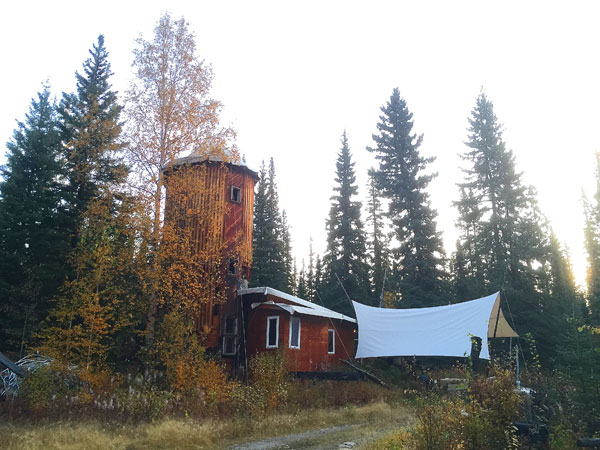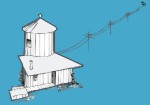FAIRBANKS DAILY NEWS MINER – Sunday, March 23, 1986
Say hello to the silo

A dairy stalwart now striking, comfy abode
Story by DEBBIE CARTER
Photos by CHARLES MASON
Most people don’t look at an abandoned grain silo and envision a three-story home, but Sandy Jamieson isn’t most people.
It happened this way. Jamieson was roaming around one of his favorite haunts, the old Miller-Bentley junkyard, one day in 1971 when he noticed the redwood that lined the inside of the old Bentley Dairy silo.
He figured it might make attractive roofing material. Once he looked closer, he knew he didn’t want to tear the fine wood apart.
The silo was about 30 feet high and 12 feet in diameter. Jamieson figured, with a little remodeling, the silo would make an inexpensive home—with redwood walls.
He says his wife, Melody, was receptive to the idea.
“It didn’t stand out from the other bizarre ideas I had.”
Bobby Miller, who ran the junkyard, told him: “It’s yours. Just don’t make a mess.”
The dairy’s farm buildings stood where the River Mall is located now, and the junkyard covered a large area, including the present site of Bentley Mall.
Jamieson faced logistics problems that would daunt less-determined men. The silo was part of the farm buildings, but it was surrounded by mounds of metal junk. The dairy. which had closed down in 1947, had evolved into a 100-acre junkyard that housed every-thing from Army tents and tanks to stoves.
Despite all the junk, Jamieson first thought he could tip over the silo and build floors in it. The floors would make provide extra support so the silo wouldn’t collapse on itself as it was moved. He investigated further, however, and discovered the silo was resting in a 5-foot concrete well.
There were other difficulties. The silo’s most recent occupants, pigeons and chickens, had left a 5-foot legacy of manure, sawdust and feathers on the silo floor. Jamieson remembers the excavation as a particularly nasty and dusty job in the hot summer weather.
“It was awful.”
Nevertheless, the silo was cleaned, three floors were built in, and Jamieson hired a 60-foot crane to pluck the silo from its base. A flatbed truck hauled the silo to Jamieson’s homestead in the heart of Goldstream Valley, where it set upright on a gravel pad.
Once there, the silo was wrapped like a cocoon with 6 inches of insulation, covered with plywood, and then rough-cut spruce.
Jamieson framed in a series of small windows on the south side, in spots where the silo’s gates were located. The gates had provided handy access to the dairy’s grain.
The floors were finished, with sections of 2-by-6 tongue-and-groove lumber, organized like wedges around a wagon hub. Narrow spiral staircases curved around the outside of the silo’s inside wall.
An attached wanigan, which was carefully connected with the silo, provided a kitchen area and a wood parlor stove heated the home.
The entire restoration took more money and time than Jamieson, an experienced log builder, ever figured, but he-doesn’t regret the work.
“We had a lot of fun there and it was a neat place to live.”
The first floor became a living room of sorts, the second floor was their bedroom and the top floor was a painting studio for Sandy.
The top floor also provided a view of Goldstream Valley, and of the cranes and other birds that dropped in on the homestead.
Vertical living had its problems though. The air in the silo home stratified and was drafty, says Jamieson. It also was a difficult job getting a heavy oak antique dresser and bed up the narrow spiral stairway.
He and Melody lived there four years, before their growing family forced them to find larger quarters.
Jamieson sold the silo to a local teacher and his wife, Joseph and Cindy Czeckala, who lived in it several years and continued the finishing work.
The present occupants are Dae and Susan Miles, who are trying to buy it from Czeckala.
It was love at first sight for Miles, who was out looking for another house in the neighborhood when he spotted the silo.
Miles and his wife, Susan, operated the Alaska Stew Pot, a mobile restaurant on College Road that sold hearty reindeer and vegetarian grain stews last summer.
The idea of living in a grain silo seemed appropriate, says Miles. He is setting up a general store nearby, in which he hopes to sell whole grains.
This is not the first vertical living for Miles, who has also once built a four-story –tower” near College. He is eyeing another silo in town for a possible addition and thinking about adding a dome on top, to provide a vista for the northern lights.
Although the silo is cozily heated by an oil stove, air spaces between the cedar makes silo living chilly proposition when the wind blows. The boards have apparently loosened over the years. Miles hopes to tighten the cables that surround the silo, or to seal the silo with a heavy plastic.
The top floor provides storage for garden supplies, but the Miles, who are both weavers, plan to make it a weaving room.
The silo wasn’t Jamieson’s only involvement with historic buildings. He restored an old roadhouse near Delta and the Episcopal Mission of Our Savior at Tanana, and has done other consulting work co restorations.
The interest developed when he was a boy growing up in Selma, Ala. The town was like a living museum, he said, because Civil War rubble and some buildings were “unchanged from the time smoke cleared from the battle.”
The silo wasn’t a true restoration job, but Jamieson is glad he saved the building.
“I think I’m glad it wasn’t just a pile of boards somewhere.”

